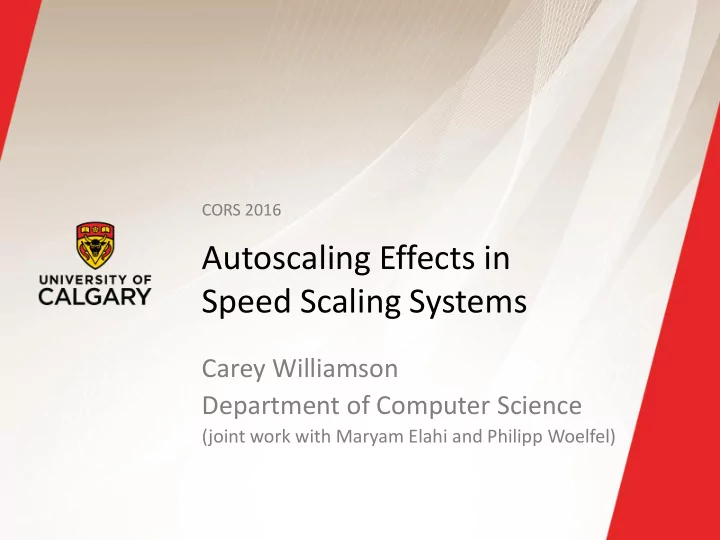

CORS 2016 Autoscaling Effects in Speed Scaling Systems Carey Williamson Department of Computer Science (joint work with Maryam Elahi and Philipp Woelfel)
Introduction ▪ Dynamic CPU speed scaling systems ▪ Service rate adjusted based on offered load ▪ Classic tradeoff: — Faster speed lower response time, higher energy usage ▪ Two key design choices: — Speed scaler: how fast to run? (static, coupled, decoupled) — Scheduler: which job to run? (FCFS, PS, FSP, SRPT, LRPT) ▪ Research questions: — What are the “ autoscaling ” properties of coupled (i.e., job - count based) speed scaling systems under heavy load? — In what ways are PS and SRPT similar or different? 2
Related Work ▪ [Albers 2010] “Energy -Efficient Algorthms ”, CACM ▪ [Andrew et al. 2010] “Optimality, Fairness, and Robustness in Speed Scaling Designs”, ACM SIGMETRICS ▪ [Bansal et al. 2007] “Speed Scaling to Manage Energy and Temperature”, JACM ▪ [Elahi et al. 2012] “Decoupled Speed Scaling”, QEST, PEVA ▪ [Wierman et al. 2009] “Power -Aware Speed Scaling in Processor Sharing Systems”, IEEE INFOCOM, PEVA 2012 ▪ [Weiser et al. 1994] “Scheduling for Reduced CPU Energy”, USENIX OSDI ▪ [Yao et al. 1995] “A Scheduling Model for Reduced CPU Engergy ”, ACM FOCS 3
System Model (1 of 4) Review: Birth-death Markov chain model of classic M/M/1 queue Fixed arrival rate λ Fixed service rate μ λ λ λ λ λ … 4 0 1 2 3 μ μ μ μ μ Mean system occupancy: N = ρ / (1 – ρ ) p n = p 0 ( λ / μ ) n Ergodicity requirement: ρ = λ / μ < 1 U = 1 – p 0 = ρ 4
System Model (2 of 4) Birth- death Markov chain model of classic M/M/∞ queue Fixed arrival rate λ Service rate scales linearly with system occupancy ( α = 1) λ λ λ λ λ … 4 0 1 2 3 μ 2 μ 3 μ 4 μ 5 μ n-1 p n = p 0 ∏ (λ /(i+1) μ ) Mean system occupancy: N = ρ = λ / μ i=0 System occupancy has Poisson distribution U = 1 – p 0 ≠ ρ Ergodicity requirement: ρ = λ / μ < ∞ FCFS = PS ≠ SRPT 5
System Model (3 of 4) Birth-death Markov chain model of dynamic speed scaling system Fixed arrival rate λ Service rate scales sub-linearly with system occupancy ( α = 2) λ λ λ λ λ … 4 0 1 2 3 √ √ √ √ μ 2 μ 3 μ 4 μ 5 μ n-1 Mean system occupancy: N = ρ 2 = ( λ / μ ) 2 √ p n = p 0 ∏ (λ /( i+1) μ ) i=0 System occupancy has higher variance than Poisson distribution Ergodicity requirement: ρ = λ / μ < ∞ 6
System Model (4 of 4) Birth-death Markov chain model of dynamic speed scaling system Fixed arrival rate λ Service rate scales sub-linearly with system occupancy ( α > 1) λ λ λ λ λ … 4 0 1 2 3 α α α α √ √ √ √ μ 2 μ 3 μ 4 μ 5 μ n-1 Mean system occupancy: N = ρ α = ( λ / μ ) α α √ p n = p 0 ∏ (λ /( i+1) μ ) i=0 System occupancy has higher variance than Poisson distribution Ergodicity requirement: ρ = λ / μ < ∞ 7
Analytical Insights and Observations ▪ In speed scaling systems, ρ and U differ ▪ Speed scaling systems stabilize even when ρ > 1 ▪ In stable speed scaling systems, s = ρ (an invariant) ▪ PS is amenable to analysis; SRPT is not ▪ PS with linear speed scaling behaves like M/M/∞, which has Poisson distribution for system occupancy ▪ Increasing α changes the Poisson structure of PS ▪ At high load, N ρ α (another invariant property) 8
PS Modeling Results 9
SRPT Simulation Results 1 0
Comparing PS and SRPT ▪ Similarities: — Mean system speed (invariant property) — Mean system occupancy (invariant property) — Effect of α (i.e., the shift, the squish, and the squeeze) ▪ Differences: — Variance of system occupancy (SRPT is lower) — Mean response time (SRPT is lower) — Variance of response time (SRPT is higher) — PS is always fair; SRPT is unfair (esp. with speed scaling!) — Compensation effect in PS — Procrastination/starvation effect in SRPT 1 1
Busy Period Structure for PS and SRPT (simulation) 1 2
Simulation Insights and Observations ▪ Under heavy load, busy periods coalesce and U 1 ▪ Saturation points for PS and SRPT are different — Different “overload regimes” for PS and SRPT — Gap always exists between them — Gap shrinks as α increases — Limiting case ( α = ∞) requires ρ < 1 (i.e., fixed rate) ▪ SRPT suffers from starvation under very high load ▪ “Job count” stability and “work” stability differ 1 3
Conclusions ▪ The autoscaling properties of dynamic speed scaling systems are many, varied, and interesting! — Autoscaling effect: stable even at very high offered load (s = ρ ) — Saturation effect: U 1 at heavy load, with N ρ α — The α effect: the shift, the squish, and the squeeze ▪ Invariant properties are helpful for analysis ▪ Differences exist between PS and SRPT — Variance of system occupancy; mean/variance of response time — Saturation points for PS and SRPT are different — SRPT suffers from starvation under very high load ▪ Our results suggest that PS becomes superior to SRPT for coupled speed scaling, if the load is high enough 1 4
Recommend
More recommend